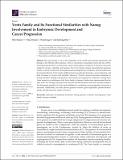Files in this item
Ventx family and its functional similarities with Nanog : involvement in embryonic development and cancer progression
Item metadata
| dc.contributor.author | Kumar, Shiv | |
| dc.contributor.author | Kumar, Vijay | |
| dc.contributor.author | Li, Wenchang | |
| dc.contributor.author | Kim, Jaebong | |
| dc.date.accessioned | 2022-03-02T10:30:16Z | |
| dc.date.available | 2022-03-02T10:30:16Z | |
| dc.date.issued | 2022-03-01 | |
| dc.identifier | 278087464 | |
| dc.identifier | 7df08e42-4b15-46f5-bcaa-45928095c414 | |
| dc.identifier | 85125415775 | |
| dc.identifier | 000769136300001 | |
| dc.identifier.citation | Kumar , S , Kumar , V , Li , W & Kim , J 2022 , ' Ventx family and its functional similarities with Nanog : involvement in embryonic development and cancer progression ' , International Journal of Molecular Sciences , vol. 23 , no. 5 , 2741 . https://doi.org/10.3390/ijms23052741 | en |
| dc.identifier.issn | 1422-0067 | |
| dc.identifier.uri | https://hdl.handle.net/10023/24975 | |
| dc.description | This study was supported by Biotechnology and Biological Sciences Research Council-BBSRC-UK (BB/T003146/1) and the Basic Science Research Program through the National Research Foundation of Korea (NRF), which is funded by the Ministry of Education, Science, and Technology of Korea (2016R1D1A1B02008770 and 2021M3H9A1097557). | en |
| dc.description.abstract | The Ventx family is one of the subfamilies of the ANTP (antennapedia) superfamily andbelongs to the NK-like (NKL) subclass. The Ventx family is a homeobox transcription factor and has a DNA-interacting domain evolutionarily conserved throughout vertebrates. It has been extensively studied in Xenopus, zebrafish, and human. The Ventx family contains transcriptional repressors widely involved in embryonic development and tumorigenesis in vertebrates. Several studies have documented that the Ventx family inhibited dorsal mesodermal formation, neural induction, and head formation in Xenopus and zebrafish. Moreover, Ventx2.2 showed functional similarities to Nanog and Barx1, leading to pluripotency and neural-crest migration in vertebrates. Among them, Ventx protein is an orthologue of the Ventx family in humans. Studies have demonstrated that human Ventx was strongly associated with myeloid-cell differentiation and acute myeloid leukemia.The therapeutic potential of Ventx family inhibition in combating cancer progression in humans is discussed. Additionally, we briefly discuss genome evolution, gene duplication, pseudo-allotetraploidy, and the homeobox family in Xenopus. | |
| dc.format.extent | 26 | |
| dc.format.extent | 1420734 | |
| dc.language.iso | eng | |
| dc.relation.ispartof | International Journal of Molecular Sciences | en |
| dc.subject | Xenopus | en |
| dc.subject | Zebrafish | en |
| dc.subject | Embryonic development | en |
| dc.subject | Homeobox Nanog | en |
| dc.subject | Genome evolution | en |
| dc.subject | Tumorigenesis | en |
| dc.subject | Ventx family | en |
| dc.subject | QH426 Genetics | en |
| dc.subject | SDG 3 - Good Health and Well-being | en |
| dc.subject.lcc | QH426 | en |
| dc.title | Ventx family and its functional similarities with Nanog : involvement in embryonic development and cancer progression | en |
| dc.type | Journal item | en |
| dc.contributor.institution | University of St Andrews. School of Psychology and Neuroscience | en |
| dc.contributor.institution | University of St Andrews. Institute of Behavioural and Neural Sciences | en |
| dc.identifier.doi | https://doi.org/10.3390/ijms23052741 | |
| dc.description.status | Peer reviewed | en |
This item appears in the following Collection(s)
Items in the St Andrews Research Repository are protected by copyright, with all rights reserved, unless otherwise indicated.

